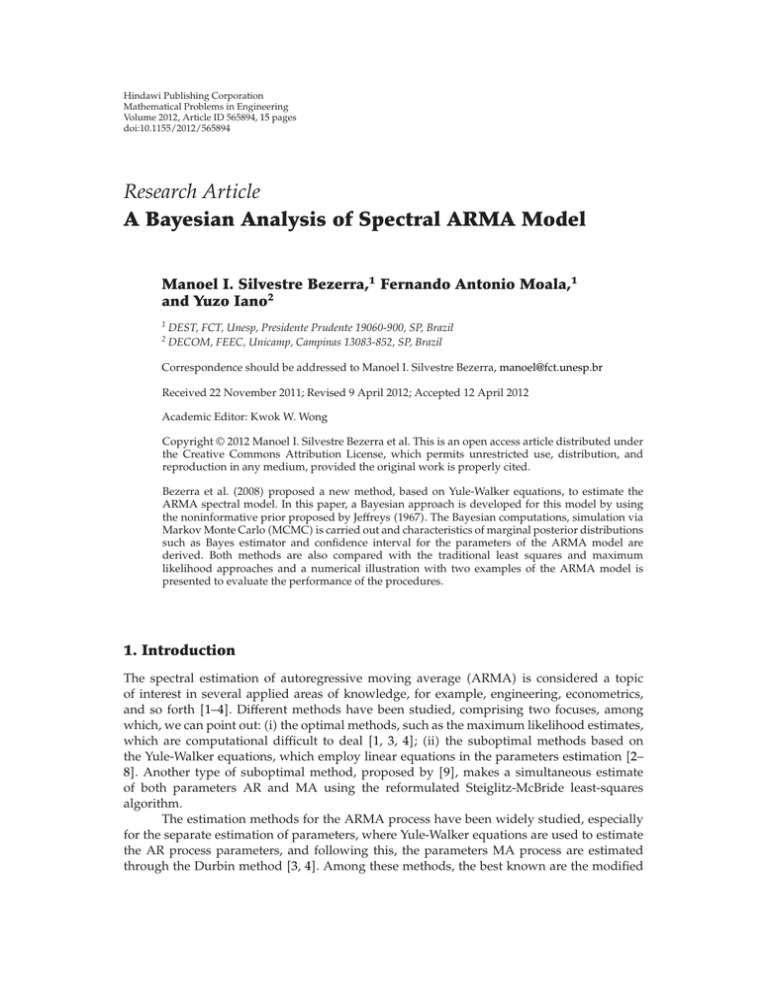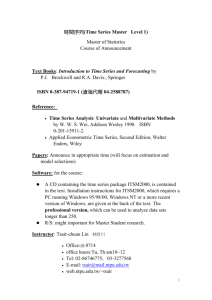Document 10953409
advertisement

Hindawi Publishing Corporation
Mathematical Problems in Engineering
Volume 2012, Article ID 565894, 15 pages
doi:10.1155/2012/565894
Research Article
A Bayesian Analysis of Spectral ARMA Model
Manoel I. Silvestre Bezerra,1 Fernando Antonio Moala,1
and Yuzo Iano2
1
2
DEST, FCT, Unesp, Presidente Prudente 19060-900, SP, Brazil
DECOM, FEEC, Unicamp, Campinas 13083-852, SP, Brazil
Correspondence should be addressed to Manoel I. Silvestre Bezerra, manoel@fct.unesp.br
Received 22 November 2011; Revised 9 April 2012; Accepted 12 April 2012
Academic Editor: Kwok W. Wong
Copyright q 2012 Manoel I. Silvestre Bezerra et al. This is an open access article distributed under
the Creative Commons Attribution License, which permits unrestricted use, distribution, and
reproduction in any medium, provided the original work is properly cited.
Bezerra et al. 2008 proposed a new method, based on Yule-Walker equations, to estimate the
ARMA spectral model. In this paper, a Bayesian approach is developed for this model by using
the noninformative prior proposed by Jeffreys 1967. The Bayesian computations, simulation via
Markov Monte Carlo MCMC is carried out and characteristics of marginal posterior distributions
such as Bayes estimator and confidence interval for the parameters of the ARMA model are
derived. Both methods are also compared with the traditional least squares and maximum
likelihood approaches and a numerical illustration with two examples of the ARMA model is
presented to evaluate the performance of the procedures.
1. Introduction
The spectral estimation of autoregressive moving average ARMA is considered a topic
of interest in several applied areas of knowledge, for example, engineering, econometrics,
and so forth 1–4. Different methods have been studied, comprising two focuses, among
which, we can point out: i the optimal methods, such as the maximum likelihood estimates,
which are computational difficult to deal 1, 3, 4; ii the suboptimal methods based on
the Yule-Walker equations, which employ linear equations in the parameters estimation 2–
8. Another type of suboptimal method, proposed by 9, makes a simultaneous estimate
of both parameters AR and MA using the reformulated Steiglitz-McBride least-squares
algorithm.
The estimation methods for the ARMA process have been widely studied, especially
for the separate estimation of parameters, where Yule-Walker equations are used to estimate
the AR process parameters, and following this, the parameters MA process are estimated
through the Durbin method 3, 4. Among these methods, the best known are the modified
2
Mathematical Problems in Engineering
Yule-Walker equations MYWEs and the method of least squares Yule-Walker LSYW.
Moreover, these methods provide similar results for ARMA spectral estimation. One of the
methods used to make the comparisons is proposed by 8.
Currently, Bayesian inference has been used successfully in practical problems also. In
Bayesian inference, the unknown parameter is considered a random variable, thus assuming
a probability distribution associated with prior, which is specified from past data or in the
expert opinion.
The main objective of this paper is to show the viability of the Bayesian approach
in estimating the parameters of the ARMA process, considering a noninformative prior
proposed by Jeffrey 10. Thus, a comparison between the classical and Bayesian estimation
methods is carried out by comparing the estimates of the parameters of the ARMA model
and consequently the estimates of the power spectrum. The mean estimates of the parameters
and their respective standard deviations are obtained from chains generated by simple Monte
Carlo simulations MCMC algorithms.
The paper is organized as follows. In Section 2, the ARMA model and its main features
are presented. Section 3 is devoted to the separate estimation methods using Yule-Walker
equations, and presents the development of the method proposed, based on the methods
described in section. In Section 4, we present a Bayesian analysis considering the Jeffreys and
independent normal prior distributions for the parameters. Section 5 deals with applications
using Monte Carlo simulations for two numerical examples.
2. The ARMA Spectral Model
Consider xt an ARMA stationary random process of order p, q, defined by the following
difference equation:
p
i0
φi xt−i q
θj εt−j , assuming a0 1, 1 ≤ t ≤ N,
2.1
j0
where φi , i 0, 1, . . . , p; θj , j 0, 1, . . . , q, are the parameters of the process and εt is a
white noise with mean zero and variance σ 2 . Thus, the vector of parameters to be estimated
is defined by
β φ1 , . . . , φp , θ1 , . . . , θq , σ 2 .
2.2
We define the power spectral density of ARMA process, in plane-z, from the system
function, by
Sz σ 2 BzB∗ 1/z
,
AzA∗ 1/z∗ 2.3
p
p
∗
∗
i1 1 − p∗i z∗i , pi , i 1, . . . , p, are the poles, and
where Az i1 1 − pi z−1
i , A 1/z
p
q
∗ ∗
∗
∗
Bz i1 1 − qi z−1
i , B 1/z i1 1 − qi zi and qi , i 1, . . . , q, are the zeros. As usual,
the stars denote complex conjugation.
Mathematical Problems in Engineering
3
The ARMA power spectral density on frequency domain is obtained by substituting
z expj2πf into 2.3 resulting in
2
2
q
σ 2 k0 θk exp −j2πfk σ 2 B f S f 2 2 .
p
A f 1 k1 φk exp −j2πfk 2.4
The function Sf is the Fourier transform of the autocorrelation function rk Ext xt−k , presumably nonnegative and periodical in frequency with period 1 Hz. It is
assumed to be band limited to ±0.5 Hz 1–3.
The problem of ARMA spectral estimation consists initially on selecting the suitable
model such that we can estimate the vector of parameters of the process and then replace the
estimates value in the spectral density function. This parametrization of the function Sf is
obtained by using the vector of parameters β.
3. Estimation Methods Using Yule-Walker Equations
There are several methods which use Yule-Walker equations in separate spectral estimation
for the ARMA model, as previously mentioned in the introduction. The methods the best
known are modified Yule-Walker equations MYWEs and the least squares modified YuleWalker LSMYW. This uses more than p linear equations in the parameters estimation. In
both methods, the errors can be weighted in order to stabilize the variance. Moreover, these
methods provide similar results for ARMA spectral estimation.
3.1. Least-Squares Yule-Walker Method
This method is an attempt to reduce the variance of the MYWE estimator and improve the
quality of their estimates. It is known that the autocorrelation function of the ARMA process
is defined as 6
rk p
φi rk−i 0,
k ≥ q 1.
3.1
i1
From the MYWE, initially we will describe the least squares method of the modified
Yule-Walker equations LSYW for the estimation of the parameters of the AR process, given
that the expanded equations of Yule-Walker for the ARMA process can be represented as
2–4, 6
r −RΦ,
3.2
4
Mathematical Problems in Engineering
where R is the expanded autocorrelation matrix M − q × p, which is given by
⎤
rq−1 · · · rq−p1
rq · · · rq−p2 ⎥
⎥
..
.. ⎥,
..
.
.
. ⎦
rM−2 · · · rM−p
⎡
rq
⎢ rq1
⎢
R⎢ .
⎣ ..
rM−1
3.3
and r is the autocorrelations vector M − q × 1 given by
T
r rq1 , rq2 , . . . , rM .
3.4
The consistent estimates of AR vector parameters Φ φ1 , . . . , φp T can be obtained by
expression 3.2. As M − q > p, there are more equations than unknowns. One error e of size
M − q × 1 in order to estimate the autocorrelations should be introduced given by
e,
r −RΦ
3.5
correspond to r and R estimators, respectively.
where r and R
It is convenient to use the unbiased autocorrelations rk to estimate r and R, so that the
bias of approximation error is null. Thus, the method of least squares can be applied to find
the vector which minimizes the sum of squares of errors, that is, 2, 6
M
S
|ek |2
3.6
kq1
or, in the matrix form:
S eT e.
3.7
Substituting the equation of the errors
e r RΦ
3.8
T r RΦ
.
S r RΦ
3.9
in 3.7, we obtain
The development of the products above in 3.9 one has the following expression results:
T RΦ
rT R
T Φ ΦT R
T r rT r.
S ΦT R
3.10
Mathematical Problems in Engineering
xt
5
1
xꉱ t
Y (z)
Figure 1: Filtering of the signal through an AR filter so as to obtain a new estimate.
Taking the partial derivatives ∂S/∂Φ 0 in expression 3.10,
∂S
T RΦ
2R
T r 0.
2R
∂Φ
3.11
estimator of the AR process, which is given by
We can obtain the Φ
−1
− R
TR
T r.
Φ
R
3.12
TR
is usually positive definite, hermitian, and Φ
estimator cannot be a
The matrix R
minimum-phase estimator 2, 3.
The estimation of AR parameters of the ARMA model through LSYW method can
be interpreted as an application of the covariance method considering the set of values
{rq−p1 , rq−p2 , . . . , rM } 2, 3. Moreover, the estimated process parameters MA can be obtained
applying the method of Durbin 3.
The performance of the LSYW, p q < M < N, is usually better than the modified
Yule-Walker equations method MYWE, where M p q number of equations, using only
p equations, but the results will also depend on the kind of spectrum to be estimated 2, 3, 5.
3.2. The Method Using AR Filter in MA Estimates
The new method for separate estimation consists of making a new AR filtering of the signal
xt by using the estimates of the MA parameters obtained with the Durbin method. Thus
determining a new signal xt , proposed by 8, as shown in the Figure 1 and according to the
expression:
xt xt − θ1 xt−1 − · · · − θq xt−q .
3.13
In Figure 1, the Hz 1/Y z is the system transfer function, and Y z 1 − θ1 z−1 −
· · · − θq z−q . This procedure is like repeating the second step of the Durbin method. This is the
key idea of the separate estimation method 3, 6.
It is known that an AR∞ process large order can be an approach for the MA process
1–4. In this method, a new signal estimate xt will be used to obtain a new AR estimate
through the LSYW method in order to subsequently determine a new MA estimate through
the Durbin method. The key idea of the method proposed is to consist of obtain a new signal,
from the AR filtering, which will provide better estimates when the parameters of the ARMA
process are reestimated.
6
Mathematical Problems in Engineering
4. Bayesian Estimation
In a Bayesian framework, the inference is based on the posterior distribution of parameters
β, denoted by pβ | x, which, in turn, is used for inferences and decisions involving β.
The posterior distribution pβ | x is obtained from the combination of the information
provided by a prior distribution fβ and the information supplied by the data through the
likelihood Lβ | x . Thus, using Bayes’ theorem, the posterior distribution is given by
p β|x ∝f β L β|x .
4.1
The prior distribution represents the knowledge or uncertainty state about the
parameter β before the experiment is run and the posterior distribution describes the updated
information about β after the data x is observed.
For an ARMAp, q model, we need to estimate the parameters β and σ where
β φ1 , . . . , φp , θ1 , . . . , θq . The likelihood function proposed in 11 for the observations X
given the vector parameters β, σ can be written as follows:
n
2
1 1
,
L β, σ | X ∝ n exp − 2
xt − μt
σ
2σ t1
where μ1 p
i1
φi xt−i q
i1
p
μt θi εt−i ,
φi xt−i i1
μt p
4.2
q
θi xt−i − μt−i θi εt−i ,
t−1
φi xt−i i1
t−1
i1
t 2, . . . , q,
it
i1
θi xt−i − μt−i q
θi εt−i ,
4.3
t q 1, . . . , n .
it
The likelihood above combined with the prior distribution results in the posterior
distribution given by
n
1
1 2
p β, σ | x ∝ n exp − 2 εt f β ,
σ
2σ t1
4.4
The values of the variables xi−p , i 1, . . . , p and error terms εi−q , i 1, . . . , q are
arbitrarily fixed.
To progress with the Bayesian analysis, it is necessary to specify a prior distribution
over the parameter space. Different prior distributions can be used in our study according to
all currently available information.
If prior information on study parameters is unavailable or does not exist for a device,
then initial uncertainty about the parameters can be quantified with a noninformative prior
distribution. This is the same to include in the analysis just the information provided by the
data.
Therefore, for the ARMA coefficients, we assume that little is known about these
parameters such that an uniform distribution can be used as a prior distribution. We also
assume a prior that the components of β are independent and hence the overall prior for β
Mathematical Problems in Engineering
7
is the product of the priors for its components. Besides, a conventional noninformative prior
distribution for the model variance σ 2 can be represented by
1
f σ2 ∝ 2 .
σ
4.5
Therefore, the joint prior distribution of β and σ 2 has the form:
1
f β, σ 2 ∝ 2 ,
σ
4.6
where −∞ < βi < ∞ and 0 < σ 2 < ∞.
Other prior specifications also could be considered, as independent informative
normal distributions for the components of β, that is, βj ∼ Nμ,σβ2 , j 1, . . .,k, with mean μ
and variance σβ2 specified a prior and an informative prior as the inverse Gamma distribution
for the parameter σ 2 , that is, σ 2 ∼ IGaσ , bσ with hyperparameters aσ and bσ known. Thus,
the joint prior for β and σ 2 would be given by
f β, σ 2 ∝ fβf σ 2 .
4.7
To obtain the marginal posterior distribution for each parameter from the model,
one needs to solve integrals involving the joint posterior density that are not analytically
tractable and which standard integral approximations can perform poorly. In this case, we
use of Markov chain Monte Carlo MCMC approaches to carry out the Bayesian posterior
inference. Specifically, we can run an algorithm for simulating a long chain of draws from
the posterior distribution, and base inferences on posterior summaries of the parameters or
functional of the parameters calculated from the samples. MCMC is essentially Monte Carlo
integration using Markov chains.
Constructing such a Markov chain is not difficult. We first describe the MetropolisHastings algorithm. This algorithm is due to 12, which is a generalization of the method
first proposed by 13.
Let gγ be the distribution of interest. Suppose at time t, γt1 is chosen by first
sampling a candidate point η from a proposal distribution q· | γt .
The candidate η is then accepted with probability:
g η q γt | η
α γ, η min 1, .
g γ q η | γt
4.8
If the candidate point is accepted, the next state becomes γt1 η. If it is rejected, then
γt1 γt and the chain does not move. The proposal distribution is arbitrary and, provided
the chain is irreducible and aperiodic, the equilibrium distribution of the chain will be gγ.
After obtaining a random sample from the MCMC algorithm for each component of
β, it is important to investigate issues such as convergence and mixing, to determine whether
the sample can reasonably be treated as a set of random realizations from the target posterior
distribution. Looking at marginal trace plots is the simplest way to examine the output
8
Mathematical Problems in Engineering
Table 1: Estimation classic AR and MA parameters standard deviation.
N 256
Method
MYWE
LSYW
LSYWS
MLE
Parameter AR
Parameter MA
−0.520
1.018
−0.255
0.240
−0.337
0.810
−0.8394
2.1903
−0.4057
0.2012
−0.5952
0.4266
−0.3760
0.4133
0.8236
1.8329
0.7724
0.2699
1.0085
0.3257
0.7283
0.4455
−0.2752
0.2346
−0.2002
0.1018
−0.3210
0.2659
−0.1764
0.1545
0.2145
0.2539
0.2252
0.0809
0.2405
0.1406
0.2167
0.1163
−0.2712
0.4057
−0.3132
0.3061
−0.3888
0.3061
−0.1954
0.4117
0.6068
0.3770
0.6867
0.2234
0.8040
0.1698
0.5418
0.4204
besides formal procedures. This way, all the values of the chain have marginal distribution
given by the equilibrium distribution.
For more details of MCMC in a variety ways to construct these chains, see, for example,
14–16.
We now describe the MCMC implementation used in our time series framework. We
generate a posterior Monte Carlo sample by simulating a Markov chain described as follows:
i choose starting values βo β0o , β1o , . . . , βko and σ02 . At step i 1, we draw a new
2
conditional on the current sample βi , σi2 using the following
sample βi1 , σi1
proposal distributions and the usual Metropolis-Hastings acceptance rule;
ii sample a new vector βi1 from the multivariate normal distribution Nk βi ; V where V is a diagonal matrix;
iii the candidate for βi1 , denoted by βprop , will be accepted with a probability given
by the Metropolis ratio:
⎫
⎧
⎨ p βprop , σi2 | X ⎬
;
α βi , βprop min 1,
⎩
p βi , σ 2 | X ⎭
4.9
i
2
iv sample the new variance σi1
from inverse Gamma distribution IGd, d − 1 ∗ σi2 ;
v because this proposal is not symmetric, we find
⎫
⎧
2
⎨ IG σi2 p βi1 , σprop
|X ⎬
2
min 1, 2 α σi2 , σprop
.
⎩ IG σprop p βi1 , σ 2 | X ⎭
i
4.10
The proposal distribution parameters V and d were chosen to obtain good mixing of
the chains.
Mathematical Problems in Engineering
9
Table 2: Estimation Bayesian AR and MA parameters standard deviation.
N 256
Method
Bayes non
Empirical Bayes
Parameter AR
Parameter MA
−0.520
1.018
−0.255
0.240
−0.337
0.810
−0.5953
0.0282
−0.5950
0.0281
1.1073
0.0291
1.1065
0.0290
−0.2650
0.0372
−0.2645
0.0372
0.2148
0.0386
0.2142
0.0389
−0.4052
0.0440
−0.4050
0.0439
0.8759
0.0469
0.8754
0.0425
Table 3: Estimation classic AR parameters standard deviation.
N 256; M 20
Method
MEYW
LSYW
LSYWS
MLE
Parameter AR
0.1
1.66
0.093
0.8649
0.1361
0.1688
0.1054
0.0299
0.1038
0.0706
0.1001
0.0275
1.6707
0.1179
1.6438
0.0483
1.6537
0.0528
1.6414
0.0395
0.1254
0.1179
0.0978
0.0323
0.0995
0.0600
0.0942
0.0363
0.8644
0.0646
0.8432
0.0472
0.8522
0.0555
0.8482
0.0404
5. Numerical Illustration
In this section, we describe the Monte Carlo simulations 17, in order to obtain the estimates
of the parameters and the spectral power density corresponding to each of the cited below
ARMA processes: 1 ARMA4,2 18 and 2 ARMA4,4 19. The simulation and the
programs were implemented in the MATLAB and R softwares.
The methods used on the simulations are 1 modified Yule-Walker equations
MYWE; 2 least squares modified Yule-Walker equations LSYW; 3 least squares modified Yule-Walker equations with AR filtering LSYWS—proposed method; 4 maximum
likelihood estimator MLE; 5 Bayesian estimator considering the noninformative priors as
Jeffreys and independence normal priors for the parameters.
In order to evaluate the performance of the methods, the random data have been
generated from the same seed and that change it with the sequences, i 1, . . . , B, and B is
the replications number in each simulation. We carried out this using N 256 observations
and B 30 replications. The random numbers are generated from a standard Gaussian
distribution white noise with mean equal zero and variance equal one, then generated a
signal of the process ARMA.
The modified covariance was the criterion in the Durbin method 3, and the large AR
process order was chosen using the criterion described by 20 and the number of equations,
M, was chosen in accordance with the spectral characteristics to be analyzed. On the other
hand, for the spectrum with poles far from the unit circle UC, as it was given in Example 5.1,
a small number was used for M, which has one pole near and other far from the unit cycle
UC.
10
Mathematical Problems in Engineering
Table 4: Estimation classic MA parameters standard deviation.
N 256; M 20
Method
MEYW
LSYW
LSYWS
MLE
Parameter MA
0.0595
0.0226
0.8175
−0.0244
0.2514
−0.0649
0.1701
−0.0681
0.1914
0.0241
0.0594
0.8848
0.2227
0.8739
0.2205
0.8879
0.2236
0.8014
0.0785
−0.0020
0.2106
−0.0137
0.2112
−0.0224
0.2262
0.0653
0.0721
0.0764
0.1291
0.2222
0.0982
0.2342
0.1070
0.2403
0.0760
0.1186
Table 5: Estimation Bayesian AR parameters standard deviation.
N 256
Method
Parameter AR
Bayes non
Empirical Bayes
0.1
1.66
0.093
0.8649
0.0967
0.0151
0.0824
0.0154
1.6029
0.0157
1.5964
0.0206
0.0875
0.0187
0.0739
0.0215
0.8102
0.0189
0.8121
0.0231
In the first example, the ARMA4,2 model was used with M 10, L 85, to N 256,
and in the second example, we used ARMA4,4 model with M 20, L 125 to N 256.
The dashed curve is theoretical and solid curve is the average of estimates.
Example 5.1. The ARMA4,2 model presented in 18 is given by
xt − 0.52xt−1 1.018xt−2 − 0.255xt−3 0.24xt−4 εt − 0.337εt−1 0 810εt−2 .
5.1
Example 5.2. The ARMA4,4 model presented in 19 is given by
xt 0.1xt−1 1.66xt−2 0.093xt−3 0.8649xt−4
εt 0.0226εt−1
5.2
0.8175εt−2 0.0595εt−3 0.0764εt−4 .
5.1. Discussion
Firstly, we consider a comparative analysis between the classical methods applied to the
ARMA4,2 model fitted by the data of Example 5.1. Thus, Table 1 shows that the LSYWS
method provided the best averages for estimate parameters than other methods, but with
a slightly larger variability than the LSYW method for the AR model. The LSYW method
produces intermediate estimates but with a superior performance than the MYWE and MLE
methods. These facts can be observed through the average estimates of the spectra power in
Mathematical Problems in Engineering
11
Table 6: Estimation Bayesian MA parameters standard deviation.
N 256
Method
Parameter MA
Bayes non
Empirical Bayes
0.8175
0.0595
0.0764
0.0151
0.0424
0.0077
0.0418
0.7556
0.0508
0.7554
0.0604
0.0518
0.0478
0.0517
0.0616
0.0525
0.0698
0.0677
0.0613
MYWE
8
6
2
4
1
2
0
0
−1
−2
−2
−4
−3
−6
0
0.2
0.4
0.6
LSYW
3
Spectral density (dB)
Spectral density (dB)
0.0226
0.8
1
−4
0
0.2
0.4
0.6
Frequency
Frequency
a
b
0.8
1
Figure 2: Density Spectral—ARMA4,2—Methods Classics.
Figures 2 and 3, which shows that the best estimate is really provided by LSYWS method
proposed by 8.
Comparing the classical methods and the Bayesian methods studied in this paper,
Table 2 shows that the estimates of parameters from both Bayesian methods are similar to
the LSYWS method, but with a smaller variability see Figure 4.
By using the noninformative Jeffreys prior, we obtained a slightly better estimate than
the empirical prior, most likely due to the mean prior given by LME does not produce so
good results. Tables 3 and 4 present the results of estimation methods MEYW, LSYW, LSYWS,
and MLE applied to the ARMA4,4 model from Example 5.2 see Figures 5 and 6. In this
case, the average estimates of the parameters were approximately equal for all considered
methods. Just the standard deviations of the mean estimates showed a difference with the
Bayesian standard deviation, see Tables 5 and 6. The standard deviation, with Jeffreys prior,
had lower value than the other methods, but with a value slightly smaller than the standard
deviation obtained by the MLE method.
12
Mathematical Problems in Engineering
LSYWS
3
2
2
1
Spectral density (dB)
Spectral density (dB)
1
0
−1
−2
0
−1
−2
−3
−3
−4
−5
LME
3
0
0.2
0.4
0.6
0.8
−4
1
0
0.2
0.4
0.6
Frequency
Frequency
a
b
0.8
1
Figure 3: Density Spectral—ARMA4,2—Methods Classics.
Bayes noninformative
2
2
1
1
0
−1
0
−1
−2
−2
−3
−3
−4
0
0.2
0.4
0.6
0.8
Empirical bayes
3
Spectral density (dB)
Spectral density (dB)
3
1
−4
0
0.2
0.4
0.6
Frequency
Frequency
a
b
0.8
Figure 4: Density Spectral—ARMA4,2—Methods Bayesian.
1
Mathematical Problems in Engineering
LSYWS
20
15
15
10
10
5
0
5
0
−5
−5
−10
MLE
20
Spectral density (dB)
Spectral density (dB)
13
0
0.2
0.4
0.6
0.8
−10
1
0
0.2
Frequency
0.4
0.6
0.8
1
Frequency
a
b
Figure 5: Density Spectral—ARMA4,4—Methods Classics.
MYWE
15
15
10
10
5
0
−5
−10
LSYW
20
Spectral density (dB)
Spectral density (dB)
20
5
0
−5
0
0.2
0.4
0.6
Frequency
a
0.8
1
−10
0
0.2
0.4
0.6
0.8
Frequency
b
Figure 6: Density Spectral—ARMA4,4—Methods Classics.
1
14
Mathematical Problems in Engineering
Bayes noninformative
15
15
10
10
5
0
−5
−10
Empirical bayes
20
Spectral density (dB)
Spectral density (dB)
20
5
0
−5
0
0.2
0.4
0.6
Frequency
a
0.8
1
−10
0
0.2
0.4
0.6
0.8
1
Frequency
b
Figure 7: Density Spectral—ARMA4,4—Methods Bayesian.
This analysis can also be confirmed by plots of the power spectra estimates 2 see
Figures 6 and 7. In this case, this similarity can be due to the ARMA4,4 has a stable power
spectrum and with more parameters to be estimated than case previous.
6. Conclusions
In this article, we describe the Bayesian approach by using the noninformative prior
distribution proposed by Jeffreys 10 to estimate the density spectral of the ARMA model.
This Bayesian approach is compared with non-Bayesian approaches LSYWS method and
LSYW, both based on Yule-Walker equations and least-squares method. Other methods
proposed in the literature as MLE and MYWE Mod-fitted Yule-Walker Equations are also
compared.
Two ARMA models with different orders were introduced to illustrate the proposed
methodologies and to examine their performances.
The study showed that the Bayesian approaches produced more accurate estimates
than the other approaches by considering ARMA4,2 model, but similar results are found
for ARMA4,4. This way, we conclude that Bayesian approach for less stable ARMA models
is justified, and more stable power spectrums any one procedures could be chosen. The
Bayesian approach provides best fitting of spectral applicable for any order of the ARMA
model than the other approaches. Finally, the choice of the approaches becomes irrelevant for
a moderate large size. In addition, generally speaking, it was seen that the results depend on
the spectrum to be estimated.
Mathematical Problems in Engineering
15
Acknowledgments
This work is supported by Capes, RH-TVD, CNPq, Faepex/Unicamp, and FUNDUNESP.
References
1 G. E. P. Box, G. M. Jenkins, and G. C. Reinsel, Time Series Analysis, Prentice Hall, Englewood Cliffs,
NJ, USA, 3rd edition, 1994, Forecasting and Control.
2 S. L. Marple, Jr., Digital Spectral Analysis with Applications, Prentice Hall Signal Processing Series,
Prentice Hall, Englewood Cliffs, NJ, USA, 1987.
3 S. M. Kay, Modern Spectral Estimation Theory and Applications, Prentice-Hall, Englewood Cliffs, NJ,
USA, 1988.
4 C. W. Therrien, Discrete Random Signals and Statistical Signal Processing, Prentice-Hall, Englewood
Cliffs, NJ, USA, 1992.
5 J. A. Cadzow, “High performance spectral estimation—a new ARMA method,” IEEE Transactions on
Acoustics, Speech, and Signal Processing, vol. 28, no. 5, pp. 524–529, 1980.
6 B. Friedlander and B. Porat, “The modified Yule-Walker method of ARMA spectral estimation,” IEEE
Transactions on Aerospace and Electronic Systems, vol. 20, no. 2, pp. 158–173, 1984.
7 M. I. S. Bezerra, “Precision of Yule-Walker methods for the ARMA spectral model,” in Proceedings of
the IASTED Conference on Circuits, Signals, and Systems, pp. 54–59, Clearwater Beach, Fla, USA, 2004.
8 M. I. S. Bezerra, Y. Iano, and M. H. Tarumoto, “Evaluating some Yule-Walker methods with the
maximum-likelihood estimator for the spectral ARMA model,” Tendências em Matemática Aplicada e
Computacional, vol. 9, no. 2, pp. 175–184, 2008.
9 B. L. Jackson, “Frequency-domain Steiglitz-McBride method for least-squares IIR filter design, ARMA
modeling, and periodogram smoothing,” IEEE Signal Processing Letters, vol. 15, pp. 49–52, 2008.
10 H. Jeffreys, Theory of Probability, Oxford University Press, London, UK, 3rd edition, 1967.
11 J. M. Marriot, N. M. Spencer, and A. N. Pettit, “Bayesian approach to selecting covariates for
prediction,” Tech. Rep., Trent University, 1996.
12 W. K. Hastings, “Monte Carlo sampling methods using Markov chains and their applications,”
Biometrika, vol. 57, pp. 97–109, 1970.
13 N. Metropolis, A. W. Rosenbluth, M. N. Rosenbluth, A. Teller, and H. Teller, “Equations of state
calculations by fast computing machines,” Journal of Chemical Physics, vol. 21, pp. 1087–1091, 1953.
14 A. F. M. Smith and G. O. Roberts, “Bayesian computation via the Gibbs sampler and related Markov
chain Monte Carlo methods,” Journal of the Royal Statistical Society Series B, vol. 55, no. 1, pp. 3–23,
1993.
15 A. E. Gelfand and A. F. M. Smith, “Sampling-based approaches to calculating marginal densities,”
Journal of the American Statistical Association, vol. 85, no. 410, pp. 398–409, 1990.
16 W. R. Gilks, S. Richardson, and D. J. Spiegelhalter, Markov Chain Monte Carlo in Practice, Chapman &
Hall, London, UK, 1996.
17 D. N. Politis, “Computer intensive methods in statistical analysis,” IEEE Signal Processing Magazine,
vol. 15, pp. 39–55, 1998.
18 A. S. W. Batista, Métodos de estimação dos parâmetros dos modelos ARMA para análise espectral [Mastership
in Electrical Engineering], FEE, UNICAMP, 1992.
19 R. L. Moses, V. Simonyte, P. Stoica, and T. Söderström, “An efficient linear method for ARMA spectral
estimation,” International Journal of Control, vol. 59, no. 2, pp. 337–356, 1994.
20 P. M. T. Broersen, “Finite sample criteria for autoregressive order selection,” IEEE Transactions on
Signal Processing, vol. 48, no. 12, pp. 3550–3558, 2000.
Advances in
Operations Research
Hindawi Publishing Corporation
http://www.hindawi.com
Volume 2014
Advances in
Decision Sciences
Hindawi Publishing Corporation
http://www.hindawi.com
Volume 2014
Mathematical Problems
in Engineering
Hindawi Publishing Corporation
http://www.hindawi.com
Volume 2014
Journal of
Algebra
Hindawi Publishing Corporation
http://www.hindawi.com
Probability and Statistics
Volume 2014
The Scientific
World Journal
Hindawi Publishing Corporation
http://www.hindawi.com
Hindawi Publishing Corporation
http://www.hindawi.com
Volume 2014
International Journal of
Differential Equations
Hindawi Publishing Corporation
http://www.hindawi.com
Volume 2014
Volume 2014
Submit your manuscripts at
http://www.hindawi.com
International Journal of
Advances in
Combinatorics
Hindawi Publishing Corporation
http://www.hindawi.com
Mathematical Physics
Hindawi Publishing Corporation
http://www.hindawi.com
Volume 2014
Journal of
Complex Analysis
Hindawi Publishing Corporation
http://www.hindawi.com
Volume 2014
International
Journal of
Mathematics and
Mathematical
Sciences
Journal of
Hindawi Publishing Corporation
http://www.hindawi.com
Stochastic Analysis
Abstract and
Applied Analysis
Hindawi Publishing Corporation
http://www.hindawi.com
Hindawi Publishing Corporation
http://www.hindawi.com
International Journal of
Mathematics
Volume 2014
Volume 2014
Discrete Dynamics in
Nature and Society
Volume 2014
Volume 2014
Journal of
Journal of
Discrete Mathematics
Journal of
Volume 2014
Hindawi Publishing Corporation
http://www.hindawi.com
Applied Mathematics
Journal of
Function Spaces
Hindawi Publishing Corporation
http://www.hindawi.com
Volume 2014
Hindawi Publishing Corporation
http://www.hindawi.com
Volume 2014
Hindawi Publishing Corporation
http://www.hindawi.com
Volume 2014
Optimization
Hindawi Publishing Corporation
http://www.hindawi.com
Volume 2014
Hindawi Publishing Corporation
http://www.hindawi.com
Volume 2014





